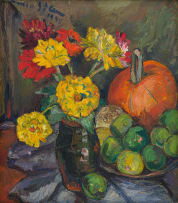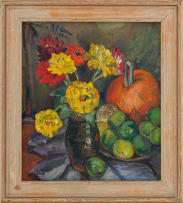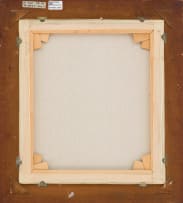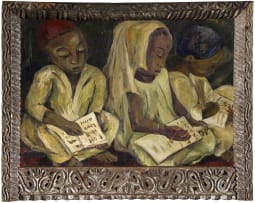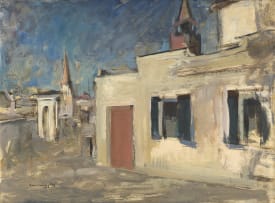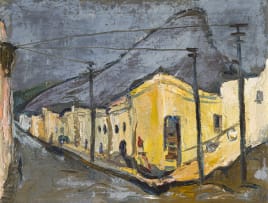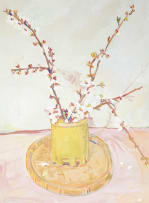Modern and Contemporary Art
Live Virtual Auction, 28 March 2023
Evening Sale
Incl. Buyer's Premium & VAT
About this Item
signed and dated 1948
Notes
Irma Stern's close association with painter Max Pechstein, as well as her early mimicry of his style, has seen her routinely described as an expressionist painter. The label is nominally helpful. It was the American art historian Bernard S. Myers, an expert on German expressionism and Mexican art, who observed: 'Where Impressionism is descriptive, Expressionism is deductive; where Impressionism is lyrical and gentle, Expressionism becomes excited and powerful.'1 In many respects, Stern's most prized work from the mid-1930s to the late 1940s presents a synthesis of these opposing traits.
When Stern's high-expressionist phase of the 1920s receded, it gave way to an idiosyncratic personal style characterised by description and ecstatic expression. The genre of still life, rather than portraiture, played a key role in this transition, providing Stern with a testing ground for her vivid colour experiments. 'She did not attain the fluent and evocative style that characterise her mature paintings, from about 1935, without effort,' writes art historian Marion Arnold. 'Object painting enabled her both to experiment with paint application and to determine how she related to empirical reality. The physicality of objects - their materials, surfaces, and forms - presented a challenge: description had to be balanced with expression.'2
The renovation of her painterly style drew the notice of critics and buyers alike. Edward Roworth and Bernard Lewis, two of Stern's fiercest detractors, were fulsome in their praise of her flower paintings. In 1936 the Union government acquired two oils depicting flowering gum and camellia for the South African embassy in Washington DC. This lot dates from 1948. Praise for her flower paintings had only grown. 'When Miss Stern tackles flowers and plants, one is conscious that she is dealing with things as much alive as the people [she portrays],' declared The Cape Times in 1947.3 This vitality owed much to Stern's assured process of laying down paint on canvas. 'The strokes are final,' noted a visitor to her studio. 'There is an
inevitability about them.'4
The abundant fruit in Stern's flower composition, while plainly compositional devices, also function as symbols of fertility and beauty. Stern frequently incorporated pumpkins into her mature flower paintings. Notable examples include Still life with Chrysanthemums and a Pumpkin (1937) and Chrysanthemums (1945), both works redolent of Van Gogh's suite of sunflower paintings from 1888. Later works include Still Life with Blossoms and Pumpkins (1964) and Irises (1964). The important work Black Lilies (1941) includes a slice of bright orange pumpkin, a decorative device not uncommon in Stern's still lifes. The glazed vase appearing in this lot also appears in a 1949 composition with sectioned watermelons.
Stern's pumpkin is a reminder of the role of food in European history and art. Pumpkins were introduced to Europe by Spanish navigators after their discovery in the Americas and shortly appeared in still life paintings. Examples include Caravaggio's Still Life with Fruit (circa 1603) and Hans Bollongier's Still life with Pumpkin and Other Fruit (1664). Signifiers of domestic vitality and mercantile wealth, pumpkins also spoke of new experiences in far-away places. Stern, a traveller, and gourmand who came of age in the twilight of Europe's globespanning imperial rule, records that awaiting potential in this composition.
1. Bernard S. Myers (1959) Modern Art in the Making, New York: McGraw Hill, page 343
2. Marion I. Arnold, (1995) Irma Stern: A Feast for the Eye, Cape Town: Fernwood Press, page 139.
3. P. H. W. (1947) Irma Stern's New Exhibition, The Cape Times, Cape Town, 7 March.
4. Morris J. Cohen (1946) Irma Stern, Johannesburg Painter, The Studio, Vol. 131, March, page 85.
Provenance
Acquired from the artist by the current owner.
Private collection.

